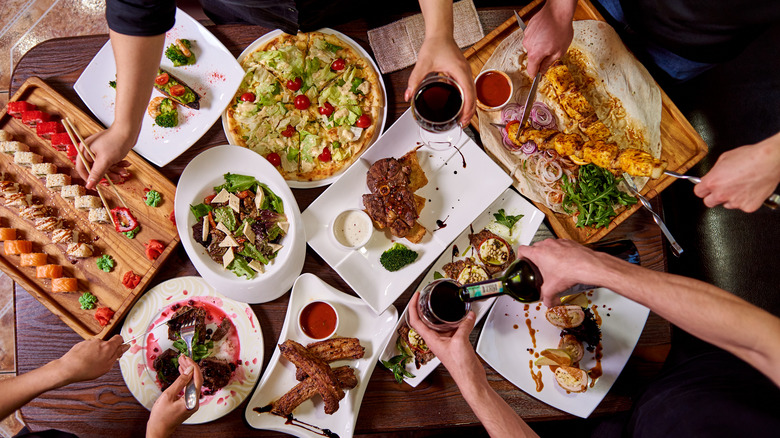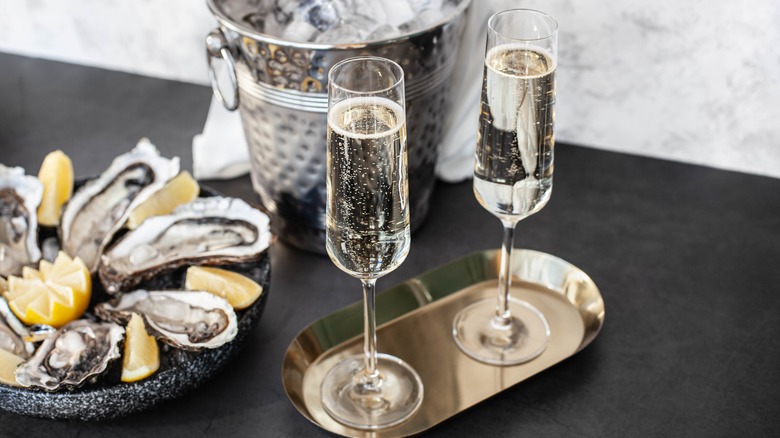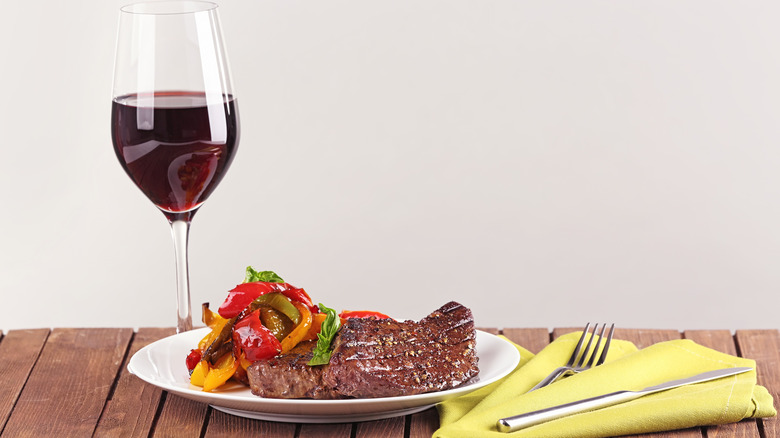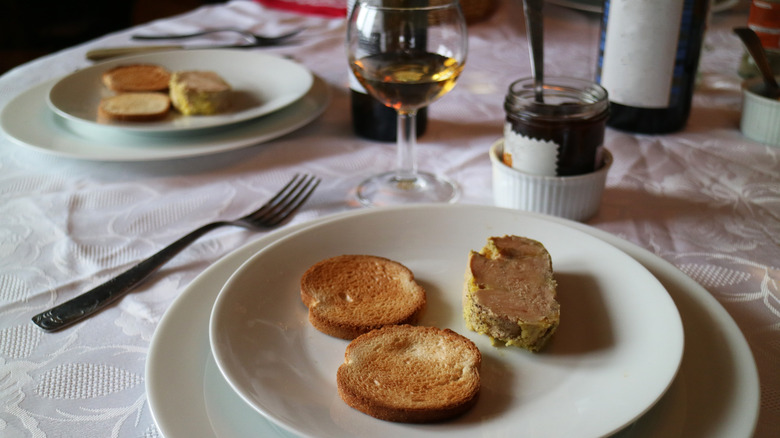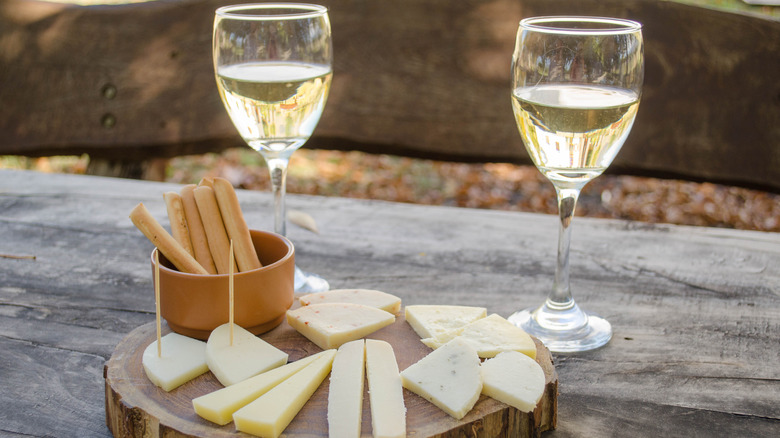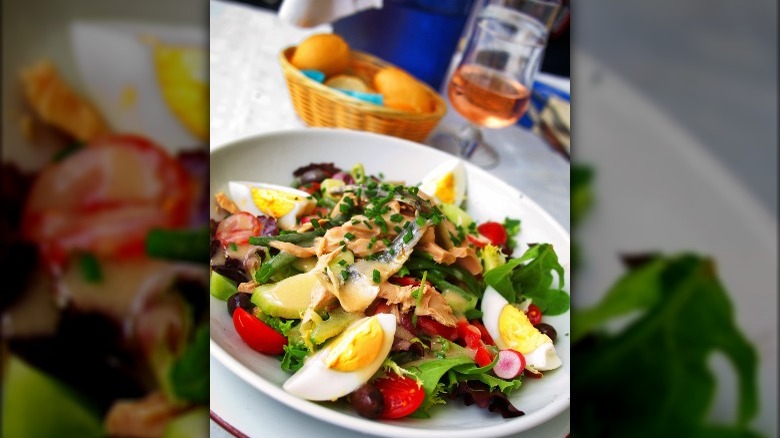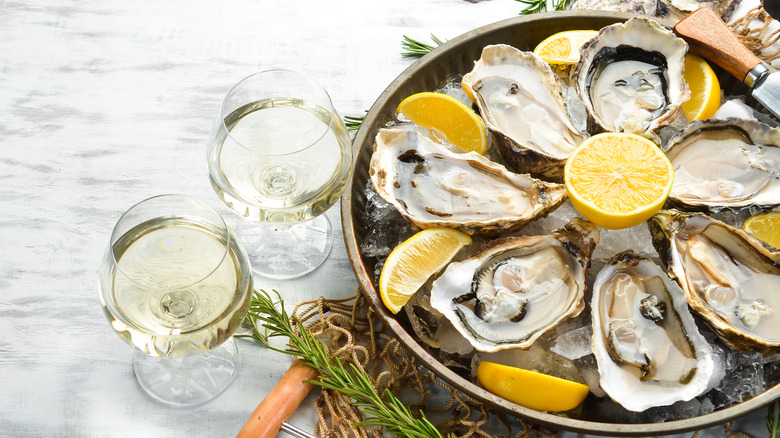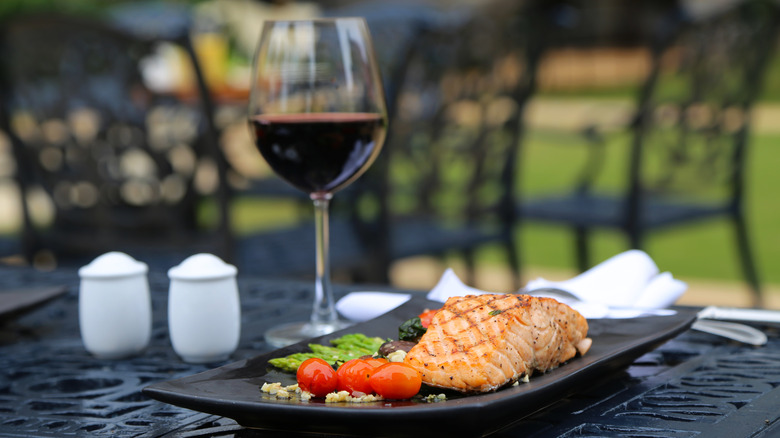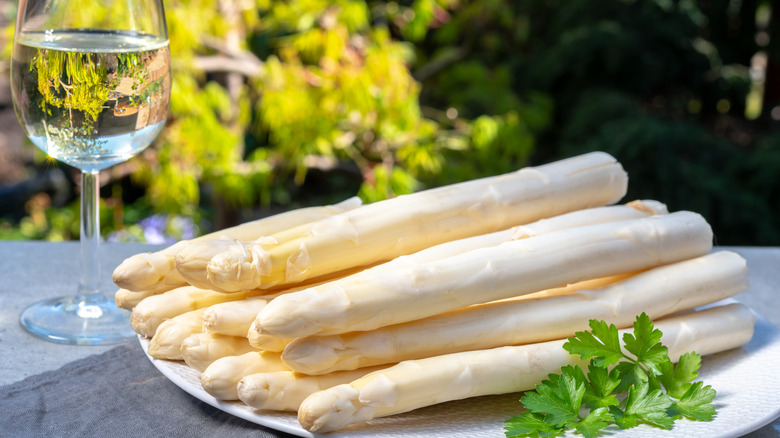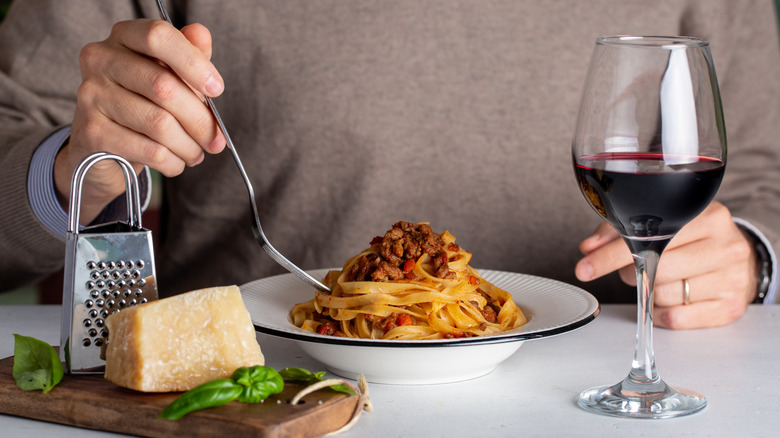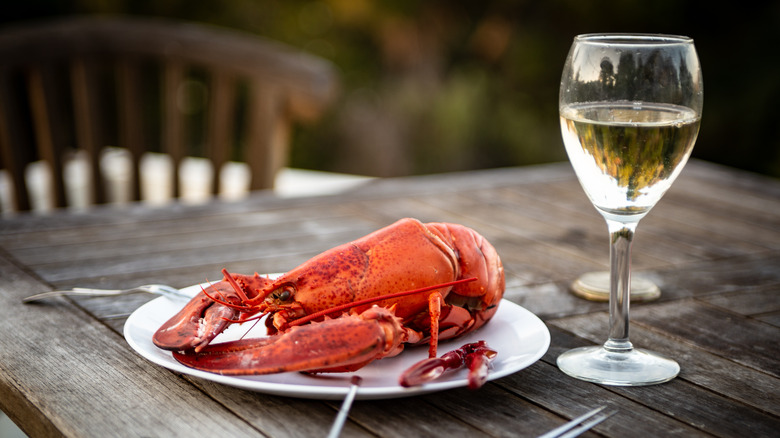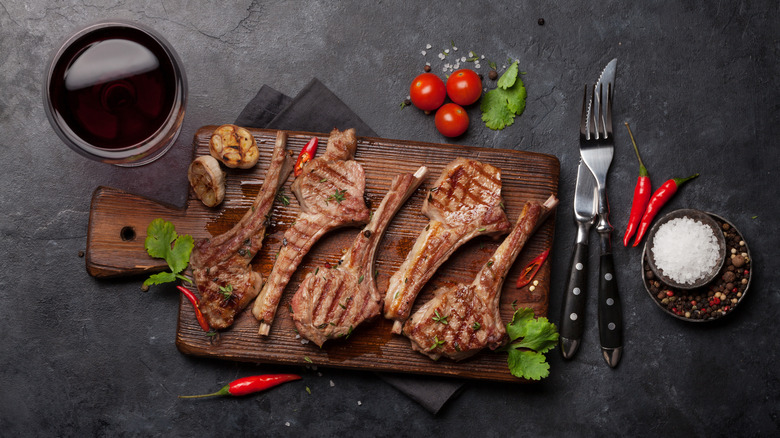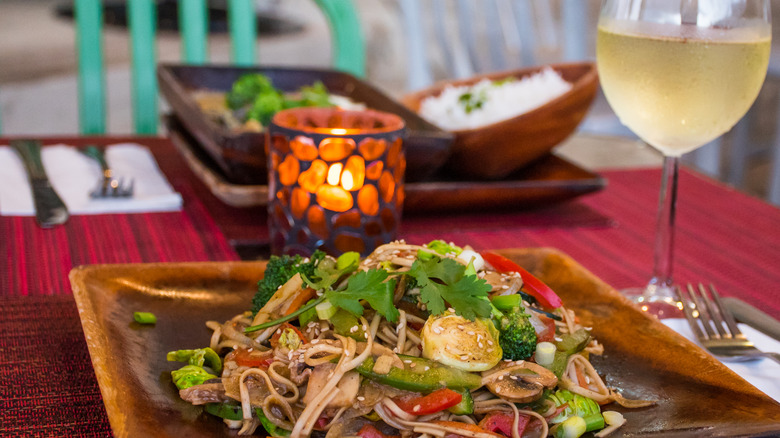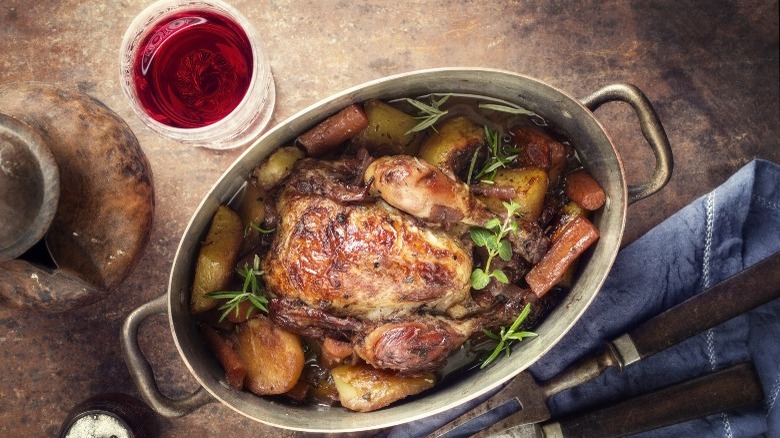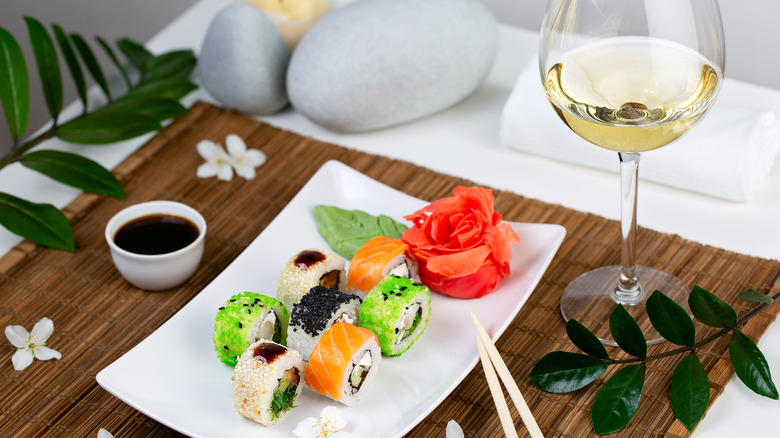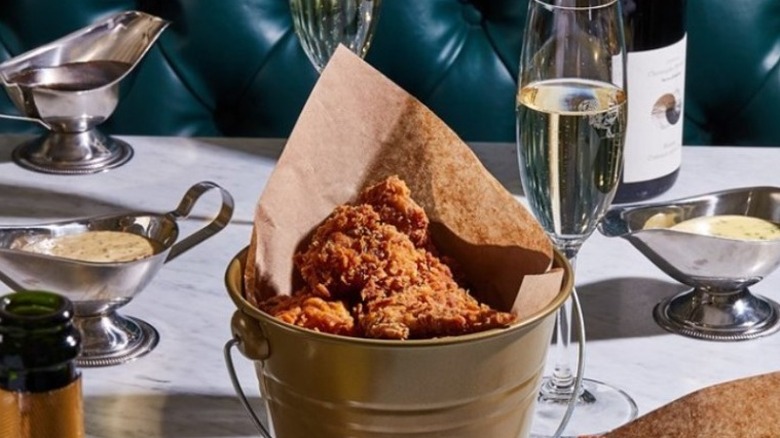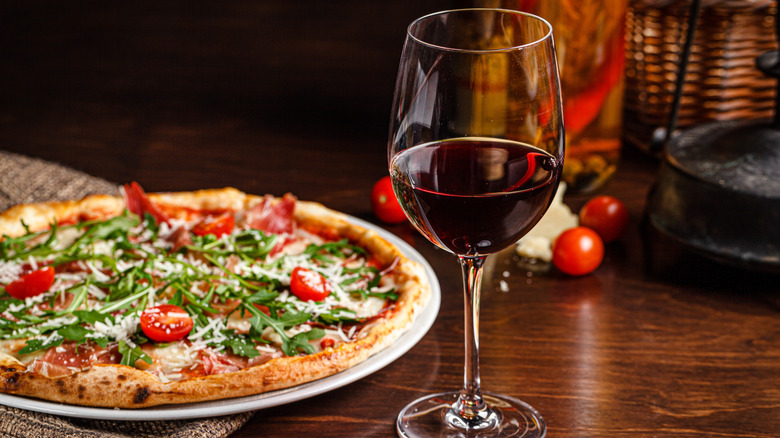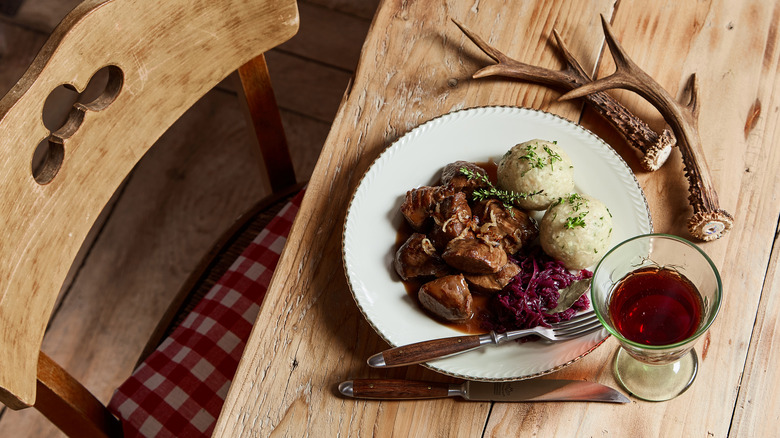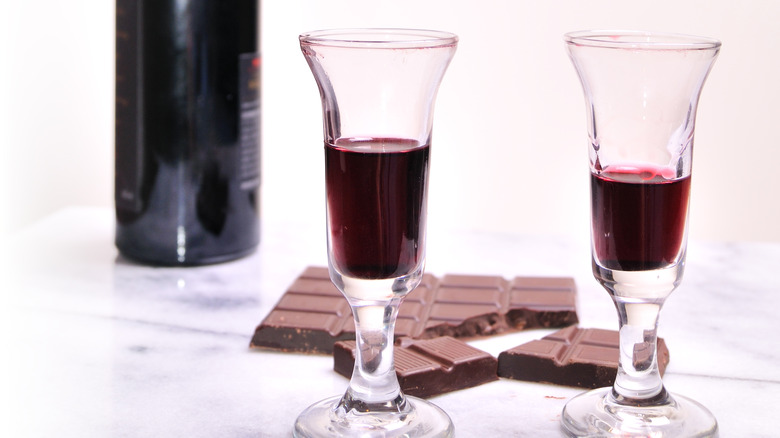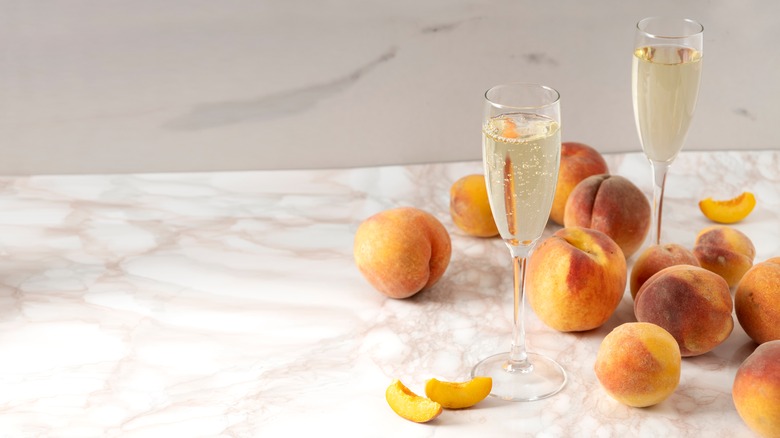Classic Wine And Food Pairings You Have To Try
Unless you spend lots of time with food and wine zealots (or are one yourself), chances are no one will give you a hard time about always having the perfect pairing. However, there's a reason why so many people are enthusiastic about certain combinations of wine and food. And while you don't have to make a fuss about it every time you open a bottle of wine, enjoying some classic pairings can be an eye-opening way to explore the wide range of flavor unions. For anyone new to the wine game, it can be less intimidating to start with the food and follow from there with some tried and true selections. Ideal food and wine pairings don't have to be a guessing game, and there are various guidelines to approach the task at hand.
Wine Folly indicates that congruent pairings occur when there are many similarities between the flavor profile of the food and wine, whereas complementary ones contrast in a balanced manner. The outlet goes deeper, looking at elements such as the six main taste components and intensity, noting that creativity is always welcome. For a full grasp on the way in which food and wine pairings can lead to magic, try one of these iconic matches that continue to impress palates everywhere. Many of these pairs seem like they were always meant to be, often reflecting the common saying, "What grows together, goes together."
Champagne & Oysters
Ordering Champagne and a dozen oysters might seem like a luxurious statement, but there's a solid reason as to why this pairing is so beloved. In fact, a 2020 study published in Scientific Reports even backs it up, reporting that "umami synergy" is responsible for the magical combination. We would have loved to have been on the research team that determined that the corresponding levels of free glutamate and nucleotides in oysters and Champagne creates the maximum amount of umami sensation.
The researchers found that aged Champagne (due to a longer time in contact with yeast cells) and European oysters were the best match, but that's not to say you should miss out on West Coast oysters and only splurge on pricier bottles. Thanks to the balance of acidity and bubbles in sparkling wine, the study's primary author explains that the mouthfeel is further amplified (via Decanter). If you aren't ready to shell out the cash for a bottle of vintage Champagne, look for sparkling wine made in the Traditional Method, which requires some time spent aging on dead yeast cells, making it a good candidate to amplify the umami synergy with the oysters.
Cabernet Sauvignon & Steak
Steakhouse regulars will recognize the well-established combination of cabernet sauvignon and steak. Once you wash down a bite of steak with a bold cab, you'll understand why they make such a great match. Sommelier Regan Jasper tells Wine Enthusiast that the duo works "as a frame," complementing the gamey flavors of the meat with dark fruits and noticeable tannins. And Eat North explains that the wine's astringency makes a great palate cleanser for a fatty steak. Conversely, the protein softens the wine, creating a smooth duo with plenty of weight.
Since cabernet sauvignon comes in a variety of styles, you can feel free to adapt your pairing to your taste and to the other components on your plate. Similarly, not all steaks are created equally — so you may want to adjust the wine depending on the cut. Jordan Winery notes that New York strip steaks make the most flexible pairing, whereas leaner or fattier meat will do best with a lighter or bolder cabernet, respectively. Unless you're grilling your steak and want a hefty wine to match, steer clear of overly high alcohol levels, which can overwhelm your palate.
Sauternes & Foie Gras
While neither Sauternes nor foie gras might make it on your regular shopping list, if you're willing to try something different, this is a combination to consider. First off, Sauternes is a dessert wine made from grapes with botrytis, also known as noble rot, according to VinePair. You might be better off not knowing that rot is responsible for the lusciously honeyed characteristics of the wine, but there you have it. With such a sweet wine, the pairing isn't always obvious, but it turns out that Sauternes is a great match for foie gras.
Although foie gras is undeniably controversial, the duck or goose liver pâté is a French specialty that producers argue is not as torturous as animal rights activists make it out to be (via Food Navigator). If you can't get on board with duck liver (or live in a state that bans it), other fatty meat pâtés can serve as a substitute. Scott Young, the beverage director of LA-based Blackhouse Hospitality restaurants, tells Eater that the buttery rich spread is pleasantly offset by the sweetness and gentle acidity of a glass of Sauternes. Follow Fauchon's advice and serve the duo as a starter or right before dessert.
Sancerre & Goat Cheese
Sancerre is the name given to sauvignon blanc wine from the region of Sancerre in France's Loire Valley, and it just so happens that it is the perfect partner for creamy goat cheese. Wine Folly explains that it's no coincidence, as the small town of Chavignol, located within the boundaries of the designated wine region, is known for its goat cheese production. Hence, the duo has been a regional pairing long before people were paying much attention to the matter. Aside from the convenience factor, the two share characteristics that work to enhance, rather than overwhelm, the flavors.
Allison Hooper makes Loire-style goat cheese in Vermont and tells VinePair that both the wine and cheese have similarly high levels of acidity that makes them a favorable match. A refreshing palate cleanser is always welcome when you're nibbling bites of creamy cheese, but aromas also play a role here. Wine Enthusiast describes that the mineral and herbal qualities of Sancerre complement the funky grass notes in your average goat cheese. Serve a glass of crisp Sancerre as an apéritif with crackers and goat cheese, or add the cheese to a salad for another tasty herbal combination.
Provence Rosé & Niçoise Salad
Here's a fun duo that will whisk you to summertime in a coastal town in the south of France. Niçoise salad comes with its fair share of variations, but typical components include tuna, green beans, tomato, black olives, and anchovies. You might find potatoes, hard-boiled eggs, and artichokes in the mix, but the main focus is on freshness. Therefore, it's only natural that an equally vibrant wine should accompany the salad.
Since the salty and bitter elements in the salad can pose a dilemma when looking for a wine pairing, taking a hint from local specialties is a solid bet. Beaux-Vins recommends choosing a Provence rosé wine to complement the regional dish. Rosé from the south of France is known for its dry finish, yet it is brimming with mineral and fruit aromas that add plenty of depth to the delicious wine (via Wine Folly). Brümate seconds the selection, noting that the understated fruitiness of the wine works well with the assorted vegetable flavors, while maintaining a bright acidity that prevents it from overpowering the food.
Chablis & Oysters
There might not be scientific evidence behind this combination, but the region of Chablis, which was once covered by the ocean, is now a combination of clay and limestone soils. Not to mention, per Burgundy Wine Company, the soils are actually partly composed of crushed oyster shells. If that isn't a clear sign that you should be pairing the crisp chardonnay with the bivalves, we don't know what is. Wine importer Jon-David Headrick tells Forbes that the makeup of the vineyard's terroir contributes to the underlying saline and mineral characteristics of the wines.
Headrick maintains that these qualities make chardonnay from Chablis an excellent pairing for briny East Coast oysters. Don't stop there; in his Oyster & Chablis Guide, oyster expert and author Rowan Jacobsen writes that Chablis manages to complement all varieties of oysters. Thanks to the balance of citrus and mineral aromas, and the wine's elegant freshness, it creates the perfect duo of flavors and textures when enjoyed with oysters. Jacobsen recommends chasing down each oyster with a gulp of Chablis for the ultimate bite. To savor the full expression of the natural flavors and pairing, avoid overwhelming your oysters with too many toppings.
Pinot Noir & Salmon
If your go-to pairing rules include white wine only with fish, we're sorry to say but you'll have to rethink that. Pinot noir and salmon, ideally lightly grilled, make an excellent match that defies traditional beliefs. As a result of salmon's bold flavor and firm texture, it can stand up to red wine, and pinot has the perfect degree of elegance and silky tannins to meet it. Châtelaine notes that aside from having low tannins, pinot has noticeable acidity that complements the fatty fish, much like the effect of lemon juice.
To add an extra layer, Food & Wine recommends pairing grilled salmon with a lightly oaked pinot from Oregon, which tends to exhibit cherry notes that will seal the flavors together. Simply Recipes goes a step further and suggests accompanying wild salmon with riper styles such as from Australia or California, farmed salmon with cool-climate pinot (try one from Oregon or Germany), and smoked salmon with earthier wines from Burgundy or Italy. Depending on its care in the vineyard and cellar, pinot noir encompasses many styles, and salmon makes a versatile match you'll love.
Grüner Veltliner & Asparagus
While it might not be as ubiquitous as other pairings we've highlighted, Grüner veltliner and asparagus are a quintessential duo in Austria, according to wine writer Fiona Beckett. First of all, Austrians love seasonal asparagus, going so far as to label the combination with local wine as the "delicious essence of springtime" (via Austrian Wine). The two regional specialties are natural complements thanks to the herbal and citrus aroma of the wine, which is ideal when paired with green vegetables.
Wine Folly adds that grüner's refreshing acidity makes it a flexible food wine, and it accomplishes the tricky task of balancing out some bitter notes from green vegetables. Try adding asparagus to a mixed salad or serving it up as a soup. Alternatively, the zesty crisp wine provides a refreshing contrast to typical Austrian preparations where white asparagus is served with creamy buttery sauces such as hollandaise.
Chianti & Pasta with Ragù
Although Hannibal Lecter was pleased to pair liver and fava beans with his glass of Chianti, we have more of a traditional approach here. Chianti is the prized wine of Tuscany, primarily made with the sangiovese grape, according to Wine Folly. Common characteristics of the wine include a high acidity, noticeable tannins, and rustic herbal aromas. In particular, the acidity makes Chianti perfect for pairing with high acid foods, and tomatoes, a common ingredient in Italian cuisine, are also acidic. These overlapping qualities make the two an easy match, but let's skip the plate of raw tomatoes and go a step further.
Since the tannins in the wine can dry out your mouth, fattier preparations such as pasta with meat sauce are perfect for counterbalancing this effect. Wine writer Fiona Beckett is a proponent of spaghetti with Bolognese sauce or meatballs paired with Chianti. She's not the only one; Drink and Pair notes that a candle sits in an old bottle of Chianti in the classic spaghetti scene in the "Lady and the Tramp." It's easy to spot since there was a time when cheaply produced Chianti was sold in fiascos (bottles wrapped in a wicker basket) as seen in the Disney movie (via Food & Wine). If you want to stick with regional specialties, Tuscan ragù al cinghiale (wild boar sauce) is an obvious choice.
Oaked Chardonnay & Lobster
If you're about to enjoy a lobster dinner, do yourself a favor and pour yourself a glass of chardonnay to savor it. Wine expert Fiona Beckett recommends choosing a subtler wine if your lobster dish is served cold, whereas lobster that's grilled or served with browned sauces can stand up to a more pronounced wine (via Decanter). Since both lobster and chardonnay can take on a wide range of styles, let's focus on a rich, buttery dish with a lightly oaked wine.
Due to its versatility, you can find numerous examples of chardonnay from Burgundy, Australia, California, or Chile that enhance lobster and the flavors of the sea (via The Spruce Eats). Consequently, chardonnay works both to complement and contrast the flavors of the lobster. Especially when aged in oak, chardonnay's buttery flavors are often present, and these act to highlight the similar taste in typical lobster preparations (via Wine Folly). Meanwhile, chardonnay can also have a citrusy element that acts as a pleasant contrast to some heavier lobster preparations.
Zinfandel & BBQ
For a classically American combination, bring a bottle of zinfandel to your next barbecue. In particular, SF Gate recommends a wine from northern Sonoma, California, which tends to be brighter and display spicy aromas. Nonetheless, there's nothing light about zinfandel, and the tannins and dark fruit flavors are a perfect match for a piece of grilled meat (lamb, beef, sausages, burgers, and even chicken are all great options). Keep it simple with the sauces and if you're going heavy on the spice, SF Gate warns to stick to a lower alcohol wine for the most pleasant experience.
According to Robb Report, zinfandel's overwhelmingly juicy fruit flavors are a great match for characteristic barbecue dishes. Part of the winning combination is that the wine's fruitiness is often perceived as sweetness, complementing fruitier sauces. To really understand the magic, try a glass of zinfandel with some saucy grilled ribs. Some acidity and tannin will cut through the meat, but you'll still be left with the pleasant blend of dark fruits, spices, and smokiness.
Off-Dry Riesling & Spicy Thai food
Certain cuisines that aren't traditionally associated with wine can be tricky to pair, so once you find a successful duo, you'll want to keep it on hand. Thai food is often enjoyed with beer to wash down the spice and keep the freshness of the dishes alive. However, an off-dry riesling can do exactly that, Fiona Beckett writes. Beckett suggests that the spicier the dish, the sweeter the wine you should pair with it. Serious Eats asked a handful of sommeliers, and Patrick Cappiello notes that riesling's sweetness is the perfect match to tone done some of the intensity from the heat.
If you're not used to drinking off-dry wines, sommelier Alicia Nosenzo adds that the sugar is less noticeable when paired with spice, and instead, the fruitier elements of the wine come to the forefront. In the case of riesling, lime, lemon, apple, and tropical fruits are often detected, all of which complement the common flavors found in Thai food (via Wine Folly). Riesling also has a zingy acidity and a balance of aromatic flavors and minerality that can complement many fresh Thai dishes. Plus, Cappiello notes that off-dry rieslings are lower in alcohol, so you can keep sipping without getting too tipsy.
Burgundy Pinot Noir & Coq au Vin
Not only does coq au vin require a generous slug of red wine (ideally pinot noir from Burgundy), but the combination at the dining table is equally delightful. Rooster (or chicken in modern renditions) stewed in red wine with vegetables results in a rich flavorful stew. Since poultry isn't as fatty as red meat, skip bolder, high-tannin wines, which will overpower. While you could drink the same wine that you use for the stew, having a more complex bottle at the dinner table is well worth it.
Fiona Beckett recommends a light- to medium-bodied red wine with a reasonable acidity to maximize this pairing — common characteristics of Burgundy pinot noir. Taste Atlas places the source of this dish in Burgundy, so once again we see that "what grows together, goes together." Mushrooms often show up in coq au vin recipes, and the earthier notes of a Burgundy pinot are a welcome complement (via Drink and Pair). Finally, the fruitier notes in the wine provide a freshness that "lightens" the weight of the stew. It's a must-try!
Dry Riesling & Sushi
Depending on the rolls you choose, sushi makes a light meal filled with fresh seafood. What better way to highlight these features than to serve it with a crisp, minerally riesling? former wine director of Sushi Note restaurant in LA Claire Coppi told Forbes that high-acid white wines such as riesling work well with the varied selection of fish you'll find in a sushi platter. Fattier fish will contrast nicely with the sharp edge of a high-acid wine, whereas lighter seafood is complemented by the citrus and floral elements in the wine.
Thanks to riesling's aromatic and mineral profile, it provides an excellent balance to a wide range of sushi rolls, especially simpler styles like nigiri and sashimi (via The Japanese Bar). However, Coppi warns that in order to avoid overwhelming your palate, don't overdo it on the soy sauce, wasabi, and ginger. Likewise, if your go-to sushi order includes lots of spicy rolls, you may want to look for a riesling that is slightly off-dry.
Champagne & Fried Chicken
One could describe this as a high-low pairing, since Champagne is more commonly associated with oysters or caviar. However, it turns out that the bubbles and high-acidity of the sparkling wine make it an excellent palate cleanser to wash away greasy fried chicken. If you think about it, soft drinks have bubbles and are generally high in acid (via Live Science). Additionally, after fermentation, Champagne remains in contact with dead yeast cells (it's not as gross as it sounds), which contribute to brioche-like flavors in the wine (via Grub Street). These flavors parallel the breaded chicken in all of its crispy, fried glory.
KFC totally backs up the Champagne pairing, noting that it's a regular duo Southerners especially love. In fact, Southern Living dubs it "this summer's power couple." But there's no reason you should limit it to one season. If you're imagining your money quickly dwindling with every bottle of Champagne, Grub Street confirms that any sparkling wine made in the Traditional Method will have similar qualities. Spanish Cava offers great value, and French or American sparkling wines can re-create this fabulous duo.
Barbera & Pizza
It's only fair to pair pizza with wine from Italy — and it's not only a matter of origin, as you'll quickly realize once you taste the harmonious duo. Since pizza comes in every style under the sun, we'll focus on a classic Margherita with tomatoes sauce and mozzarella to start. With their high levels of acidity, tomatoes shine with a wine that's equally vibrant. A simple pizza highlights the nuances of basic ingredients, so it's important to avoid overpowering these subtleties. Hence, barbera from the Piedmont region of Italy makes a delicious pairing, partly owing to the wine's fresh acidity, according to Wine Folly.
Juli Gregg, the wine director of San Francisco Tony's Pizza Napoletana, tells Eater that barbera's medium body and noticeable acidity make it an excellent pairing for food, refreshing your palate with every sip. Gregg adds that the wine's fruitiness is a welcome complement for the cheese and tomato, and the soft tannins keep the combination light. Unlike heftier meat dishes, there's no need for bold tannins or heavy oak when you're enjoying a simple pie. Thanks to its versatile nature, barbera will taste equally great with pizzas topped with sausage, pepperoni, or vegetables.
Syrah & Game Meat
You might not be sitting down to a dinner of game meat on a regular basis, but when you do, serving it alongside a glass of syrah will enhance the experience. According to Vinum, since game meat such as pheasant and venison are relatively low in fat, high-tannin wines will overpower the subtleties of the meat. Syrah wine, especially from the Northern Rhône in France, has a polished elegance that makes it a balanced pairing with options like rabbit, elk, or moose. As Wine Folly notes, syrah boasts meaty, tobacco notes, which contribute to extra layers of depth in the pairing.
Vinum adds that pepper, smoke, and dark berry flavors are common in syrah, all of which pair seamlessly with game meat. In fact, these meats are regularly served with berry-based sauces to highlight their herbal savoriness, and the wine manages to tie it all together. For bolder preparations or fattier meat, wine writer Marissa Reibstein recommends weightier styles of syrah from the Southern Rhône or a shiraz from Australia.
Ruby Port & Chocolate
Although chocolate and red wine are often mentioned as being a heavenly match, the nuances of each are important to consider to avoid a bitter combination. The best way to prevent this unsavory taste is to opt for a wine that is sweeter than the dessert in question, according to Vinfolio. As such, a sweet ruby port with raspberry and dark cherry fruity characteristics makes an excellent duo with rich chocolate (via Wine Folly).
Since ruby port is a younger and lighter style of port, the fruit is at the forefront of the flavor, providing a delicious combination with a chocolate-heavy dessert. Unlike its aged counterparts, ruby port generally doesn't display complex layers of flavor, and even stands to be enhanced by the decadent flavors and textures of chocolate. Think unctuous ganache truffles or fudge for the perfect balance, or sip on some port with a piece of milk chocolate. Enjoy the overlapping flavors of fruit-infused chocolates with port or try serving it with chocolate chip cookies to finish off your meal.
Moscato d'Asti & Fruity Dessert
If your first thought about moscato is that it's cloyingly sweet, it's time you tried it with the ideal complement. Wine Folly describes Moscato d'Asti as a lightly sparkling wine brimming with floral and fruity flavors: citrus, peaches, orange blossom, honeysuckle, and more. The fizziness keeps this wine fresh, and its low alcohol content makes it a great sipper. A helpful tip when pairing sweet wines is to opt for a similar level of sweetness so that neither the food nor the wine stands out as excessive, per Fine Dining Lovers.
Thanks to the fruity, aromatic elements of moscato, it's the perfect match for fruit-forward desserts. Think buttery flaky delights and fresh fruit tarts — skip the dark chocolate here. Creamy pudding, cobbler, shortcake, and coconut-based desserts are equally welcome pairings recommended by Food & Wine. Or, jazz up a simple fruit salad with a festive twist by serving it with a glass of bubbly Moscato d'Asti.
